I’m not sure where they are, but I want to be there!

As promised, here are the photos of Ron Garza getting tattooed at Wat Bang Phra in Thailand. You can spot John Durante in the background, who happens to also be in my personal favorite modblog entry of all time.
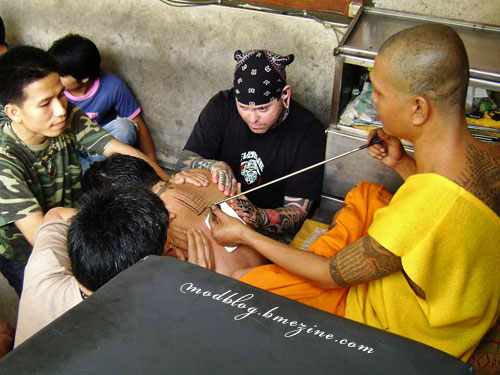
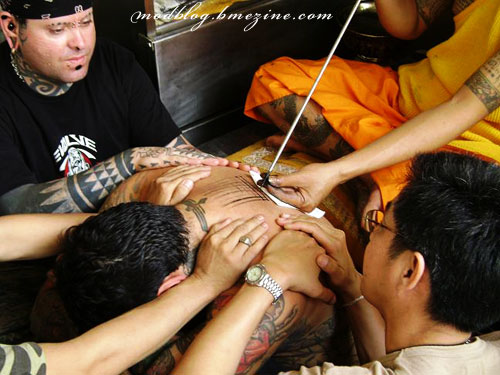
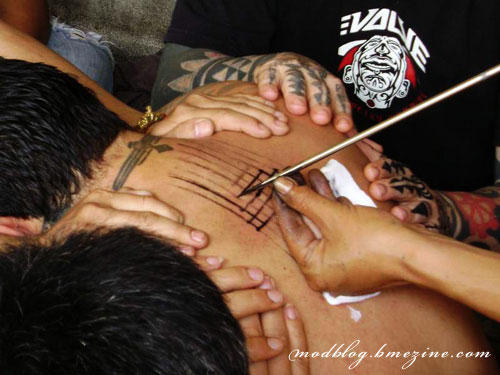
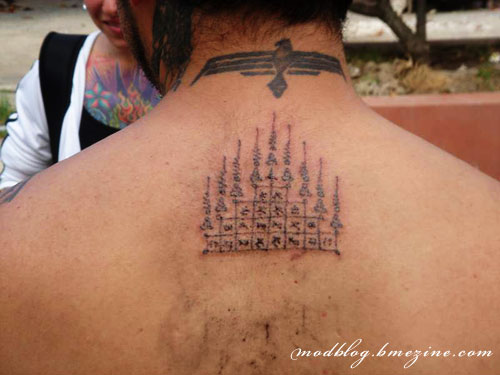
Ron Garza writes in from Thailand with photos of his hand poked tattoo but I thought this photo was so good it deserved it’s own entry. Photos of Ron and friends being tattooed coming up next!
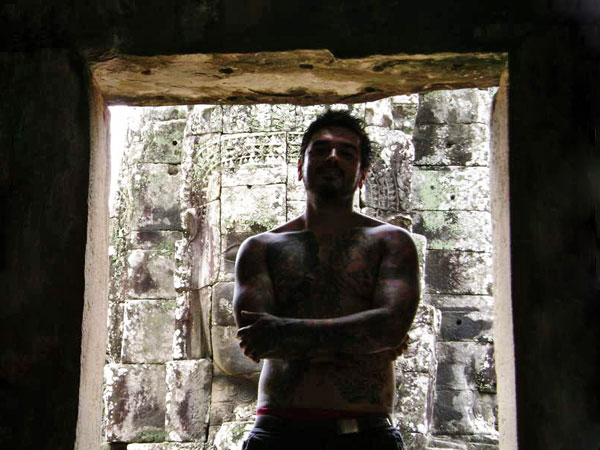
Tucker from Madhouse Of Ink in Edmonton, Alberta, Canada tattooed the flower on Pamela Page’s shoulder.
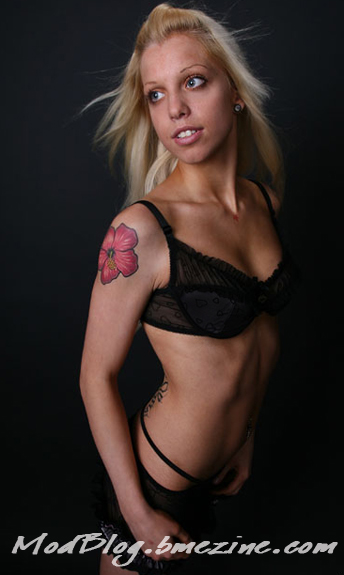
You have to really enjoy fishing to have a portrait of your favourite catch on your arm. This tattoo was done by Kathy Hays of Atomic Zombie.
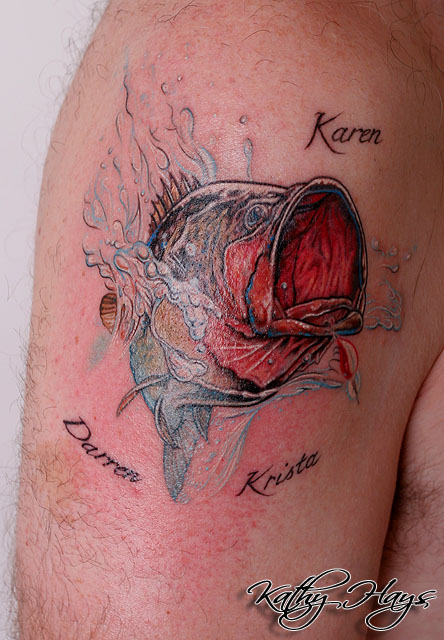
From Joy:
I was recently approached by Dr. Racanelli, a surgeon in NYC. He inquired whether I would be interested in tattooing the areola and nipple areas of his patients that have gone through breast reconstruction after mastectomies. During some surgeries, areolae and nipples are removed. Although reconstructions can create a “breast” using the surrounding tissue and implants, they cannot recreate the color of the areolae and nipple.
I told Dr. Raccanelli that I would love to help and he could give out my information to any patient who was interested. I had my first corrective/reconstruction tattoo procedure yesterday. If any one is interested, please don’t hesitate to contact me. Below are before and after pictures.



While this is Joy’s first areola and nipple reconstructive tattoo, I am positive it will not be her last!
Joy can be contacted at:
Twelve 28 Tattoo
142 Havemeyer Street
Brooklyn, NY 11211
http://www.1228tattoo.com
347.602.2560
Sometimes we pour our heart and soul into an idea. We research the hell out of every artist we can find, and we wait patiently for a consultation and then finally the day comes when we get tattooed. Then something goes wrong. The lines are a little off, the color is all wrong… it just isn’t what you wanted. What do you do when you think you’ve screwed up? What happens if your artist turns out to be nothing more than a pile of turd with a big ego? What do you do when no one will tell you what they really think? Well??
You turn to me. I’ll tell you what you really need to hear. I’ll let you know what went wrong and where you should go from here. I’ll be that little voice that says “That’s a really really bad tattoo.” And sometimes I might even say “Wow! That’s grade A work! Consider yourself lucky and make sure you help out your friends with recommendations since you obviously know what you’re doing.”
One of the hardest things about being tattooed is simply the fact that it’s permanent. The joke has always been that the worst thing you can hear your tattoo artist say is “woops!”, and it’s true. What if you just went to a bad artist for a small piece of flash? I know I’ve been there. I went in to get a small light blue star on my wrist bone. What should have been a 45 minute tattoo turned out to be a 3 hour ordeal. Of course I was 18 at the time, hardly knew any better, and I really just wanted something to remind me of my time in New Orleans. That piece has been covered up three times with black, and to this day, it’s still visible because of the scarring from the original “artist”. The one thing I can say about myself is that I learn from my mistakes and now only visit Top Shelf artists. I’m not talking about $350-an-hour artists, but those who are truly talented and care about the work that they do. I’m hoping I can help everyone learn from my and other people’s mistakes.
* * *
The first examples I have are of facial tattoos, specifically chin tattooing, which is most commonly — though incorrectly — called a Moko. “TA MOKO is a Taonga (treasure) to Maori and the purpose and applications are sacred.” — so unless you’re a Maori all you’ve got is a chin tattoo.
I have to out myself as someone who is not a big fan of chin tattoos. More often then not, they’re not symmetrical and just generally not well done, and they cause the corners of the lips to look like they’re going at a downward angle. I’m trying to compare apples to apples here so we’ve got two pictures of two freshly done chin tattoos. The first one comes from our very own IAM:Xombie.

Tattoo by Greg at Sinkin’ Ink Tattoos in Hamilton, Ontario, Canada.
While the shine of the new tattoo is a bit distracting, I can immediately see that the right hand point/line is a bit wider and longer than the left side. The right middle line is also slightly thicker. The black is very bold though and initially looks to have been evenly applied. My only recommendation for this piece is that when Xombie goes in for a touch up, that the artist bring the tops of the tattoo up to the lip line in a more even fashion and to beef up the lines on the left hand side. All in all, I think this is a good tattoo. Bravo.
I didn’t even bother to read the email that had accompanied the picture until after writing the review.
“That tattoo is basically a design with meaning. The meaning of it is that I have never felt love before until my son was born. He is the Star in the tattoo. The lines wrapping around the tattoo are a broken heart. Which symbolizes with the star in the middle of it, that since he’s the first person I have felt love for, that he is sort of mending my heart, and pulling it back together again…
The rest is just decoration.”
It’s nice to see meaning in a tattoo with such a prominent position on someone’s face.
The next example we have is on IAM:The Eternal.
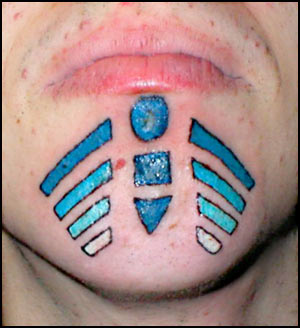
Tattoo by Rotten Ryan of William Vizgard’s Tattoo & Body Piercing in Winter Park, FL
I really hate to do this, but I think it needs to be said. This tattoo seems very poorly done. Any tattoo artist that does a design like this yet doesn’t bother to square the lines deserves to be shot. One could argue that the person getting the tattoo is also be to blame, but I don’t think that’s the case. When you go in for a tattoo, you’re incredibly excited and it’s hard to make a rational judgment call. Sometimes it’s best to bring a friend that you can trust who will give you an honest opinion. Often times, when browsing IAM, I see pictures posted of poorly done tattoos, and the only comments on them are “Hey, that’s awesome” or “Wow, great tattoo”. Perhaps the line of thinking is that there is nothing one can do to correct it, so why act negative but that’s simply not the case anymore. There are many competent artists out there. It’s just a matter of finding them and using them.
My biggest problem with this tattoo is that the right side doesn’t even come close to matching the left side. The biggest skill a tattoo artist should have is tracing. They do it day in and day out. So why do so many artists seem to have a problem with symmetry? Why wasn’t the left hand side of this traced over to make the right side? Why don’t they look the same? They’re not even on the same angles. The triangle and square in the middle are not straight. They’re slightly offset and the lines aren’t true.
The outlines are probably going to blow out. I haven’t seen a healed picture of this tattoo but that is my prediction. There will end up being a hazy shadow around it and even some dramatic blotchy marks around the edges. They also aren’t evenly applied. The ink colors also look off. My guess is that the artist mixed a darker blue with white to make the lighter blues, which is an acceptable and common practice but these colors look milky and hazy.
My personal suggestion would be a complete cover up, perhaps coupled with a little lazer removal (the two sides are off enough in places to greatly limit coverup options, but a slight touch of laser could help a lot) — maybe something similar to the example I’ve posted below, assuming the basic design motif is to be retained.
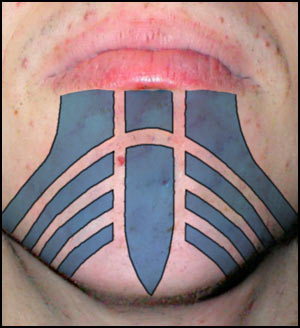
There have been many studies done showing how a baby prefers the face of a person with a more symmetrical face. Denzel Washington was voted in People magazine as one of the 50 Most Beautiful People in the world in 1990 and then People magazine’s Sexiest Man Alive in 1996. This has been attributed to the fact that he has one of the most symmetrical faces out there. While I know most people in the community balk at the thought of doing something that would make you more appealing to the masses, getting a facial tattoo that is not symmetrical almost always does exactly the opposite of that. It subconsciously makes you less attrac
tive to other people, whether they’re into tattoos or not.

Montreal Tattoo Convention 2004 Report by Rachel Larratt |
“If particular care and attention is not paid to the ladies, we are determined to foment a rebellion, and will not hold ourselves bound by any laws in which we have no voice or representation.”– Abigail Adams
Every woman I know that’s been to a tattoo convention knows what most of the photographers can be like — dodgy old men trying to convince you to come to their hotel room. You can easily recognize their sleazy work in the magazines; they’re the guys that think you have to be nude to “properly show off” that little star on your wrist.
“Want a picture of your sleeve in the magazine? Let’s get you out of that shirt and bra, sweetie. It’ll look better that way. Trust me, I’m a photographer. Now push your breasts together for me. Look sexy, baby. Why don’t you take off those pants as well? Don’t worry, honey, all the other chicks are doing it too. Don’t you want to be famous?”
Ever wonder why some tattoo magazines are full of women whose only shared characteristics are bad tattoos and bared breasts? It’s because the men taking the photos don’t care about the tattoos — they only care about getting girls naked. If you’re a regular at tattoo conventions, I’m sure you know the photographers I’m talking about. We’ve all been harassed by them. After turning them down, I have had these old men sneak back about twenty feet and take my picture with a zoom lens, only to end up with nothing but a shot of me holding up my middle finger.
This is a tradition that I want to stop.
Earlier this summer, after spending an hour at the Toronto convention and being completely disappointed in the atmosphere, I left. While I’d already told everyone I was going, I began to question my upcoming plans for the Montreal convention. Should I go? Should I spend the money on a booth? Will people be just as grumpy? After all, the French, especially the Quebecois, do have a reputation for being rude to us Anglophones.
Spending one minute at the Montreal Tattoo Convention completely shatters those stereotypes. Friendly people had come from all over the world, and it was clear that they were there to have a good time. There was no posturing or attitude, and it just felt like everyone was there to meet the top international tattoo artists and to simply enjoy the art.
Even though many of the people attending the convention spoke only French, the language barrier never hurt us at our booth. I made my way through the day with a lot of smiling and body motions to show people what I wanted them to do. I had my lovely assistant Jen translate whenever I couldn’t get my intentions through, and Phil Barbosa (who you know as the photographer who shot the ModCon book and other BME events) helped me keep the lighting and technical aspects in check.
I started off taking pictures of the few people there that I knew and then started tackling the crowds. No pressure and no sexualization. I stuck with “may I take your picture?” and people seemed to liked that. Now let me share some of those pictures with you.
 |
 |
 |
 |
 |
 |
 |
 |
 |
 |
 |
 |
 |
 |
 |
 |
 |
 |
 |
 |
 |
 |
 |
 |
 |
 |
 |
 |
 |
 |
 |
 |
 |
 |
 |
 |
I’d love to continue shooting conventions all over the world. I really had a great time taking portraits of both old friends and total strangers. Thank you to my assistants for the help, to the organizers of the convention, and especially thank you to everyone who let us shoot them. It was wonderful getting to meet all of you (and to see some of you again). I hope you enjoyed the photos, and finally let me also thank that small minority of photographers out there that understand that women with tattoos are still women deserving of respect and courtesy.

Rachel Larratt
BMEzine.com
| Rachel Larratt is the copublisher of BME.com, the largest and oldest full-spectrum body modification publication on the planet. Her background is as diverse as one would expect of BME’s coowner, and includes everything from body piercing to developing technology for high-bandwidth media distribution. |
Copyright © 2004 BME.com Requests to republish complete, edited or shortened versions must be confirmed in writing. For bibliographical purposes this article was first published July 13th, 2004 by BME.com in Toronto, Ontario, Canada..

 JewelEye (Sung to the tune of Goldfinger) |
“If you are not in fashion, you are nobody.”
– Lord Chesterfield
|
They call Amsterdam the “Ultimate City of Freedom”, or so the t-shirt I brought back for Shannon claims. The border crossing into the country didn’t involve being searched or questioned, and nothing more than pausing to get a Schippol Airport stamp in my passport held me from those freedoms — prostitutes, gambling, drugs, and euthanasia I suppose… but Jen Savage (my traveling companion and soon-to-be nurse) and I had come looking for another kind of freedom: medical freedom.
Most, if not all, of you have heard of the “JewelEye” implant that’s been upsetting conservative doctors lately — it is after all quite literally an implant under the surface of the eye. I decided to come see what it was all about… and to have it done on myself. As of Wednesday May 26, 2004, I am now the first person outside of The Netherlands to have it done.
After a short 30-minute train ride from Amsterdam to Utrecht, we stopped briefly at our hotel and then took a cab into the suburb of Driebergen where we arrived at the notorious Retina Total Eye Care. Far in fact from “notorious”, the clinic is located on a quiet shopping street open only to pedestrians and bike traffic, and looks every bit the designer clinic — walls covered with with Dolce & Gabbana, BVLGARI, Calvin Klein, and GUESS. The clinic’s center is a beautiful koi pond with bamboo growing up to the second story, and as we waited we were served apple juice and espresso.

When they were ready for me I went upstairs where they had the pre-op rooms and their full surgical suite. First I was given a complete eye exam to make sure there were no defects on my eye, and during this exam they determined the optimal positioning of the implant jewelry. The entire white of the eye is suitable for placement (so there was no “mapping of blood vessels” like in procedures such as dermal punching an ear), so the position is a combination of what I wanted and what they recommend — the goal was to have it subtle most of the time, but appear during conversation. Although one might assume it’s a hardcore mod, it’s not supposed to be “in your face”, even though it obviously is. Because we tend to look up when we’re talking, we decided to place the implant — a small platinum star — in the lower left quadrant of my left eye.
I was given a drop of anesthetic in both eyes — the eye not undergoing the procedure needed to be relaxed as well since our eyes move in unison. Two more anesthetic drops were put into my left eye, and an additional antibiotic drop was also given with the anesthetics. The drops stung a bit until they finally took effect. After that I couldn’t feel anything and my eyesight in my left eye became blurry. My hair was put into a hairnet and I changed into a surgical gown, complete with little plastic foot covers.
A sliding door opened and I was brought into an operating room. It was at this point that I really started to feel in good hands and at ease. Everything was top-of-the-line and matched the TV image of the perfect clinic. Everything was clean, white, and new. I got onto the operating table and my head was locked into place. I got another anesthetic drop, and my face around my eye was swabbed down with iodine — getting lots into the eye itself as well.
The table then rotated underneath some very bright lights and what I assume was some kind of microscope. A sterile drape was placed over my face except for a hole for my left eye. My eyelids and lashes were taped back and a claw was put under my eyelids to keep me from blinking (or “winkeling” as the doctors and nurses put it). If you’ve seen A Clockwork Orange you know what I’m talking about!
For most of the surgery I had my eye looking all the way to the right. I was convinced I wasn’t doing what they asked and was having a hard time keeping my eye in place, but they said I never moved once. I guess because my eye was moving due to the pressure that they were exerting on it, I felt that it was me moving it — but there was never any pain and hardly any pressure.
The procedure itself involved injecting a liquid to elevate and separate the layers of the eyeball, which helps the surgeon with the placement of the implant under the conjunctiva (in old age, many people build up calcium deposits in this area, so our eye is actually designed to handle material stuck there). A small flap is cut, and the implant is inserted. After it was in place, they began suctioning out the liquid that was used to elevate the layers. After a few weeks, the liquid will dissipate and the implant will become even more visible.
After removing as much of the elevation liquid (and the iodine) as possible, they removed the tape and sterile cover from my face. The tape being pulled off was actually the only pain that I felt for the entire procedure (I was worried about it pulling out my lashes, but it didn’t)! I can’t stand pulling tape off of myself after a tattoo either. It took about three minutes before I was able to sit up. I felt disorientated — staring into blinding lights while holding your eyes in an awkward position can take more of a toll on your entire body than you’d think. But still, the entire procedure from the start of the examination to getting off the table probably took less than half an hour.
I was taken back to the pre-op room where my face was cleansed of residual iodine and the surgeon gave me another exam to make sure that the implant was positioned properly. I felt very off balance because my left eye was so blurry — the fluid in my eye caused the distortion. In hindsight I’d have liked an eye patch and my eye felt much better when I kept it closed.
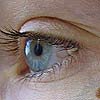
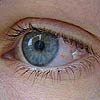
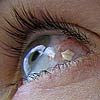

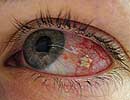
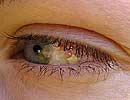
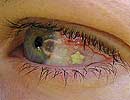
The remainder of the week was to be spent doing some whirlwind traveling (“ah, an American vacation” a few people remarked; “next time you need to stay a little longer”). First to Liege, Belgium where we met with Marisa (who you know from her legal articles here) and Dan DiMattia of Calypso Tattoo (also no stranger to BME readers). My only problem with Belgium is the sidewalks — they are only about two feet wide! It’s hard to walk in a group, let alone side by side. Conversations have to wait.
I haven’t written much about the aftercare of the JewelEye because it really was a non-issue. Other than the very slight inconvenience of having to complete my course of antibiotic eye drops over the first week, there was barely any discomfort. A scratched eye hurts worse than this did.
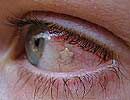
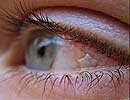
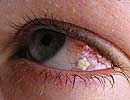
After Liege, we traveled on to Antwerp, and then up to Venlo on the high-speed train (a big let-down on which we were served some sort of vomit-based dish) where we met with Kor and his Truth Seekers Syndicate for their ritual event which had drawn people from as far as Norway (Håvve Fjell, who you know from Ten Years of Pain) and Brazil. But it was all over so quickly — next time I will try and take the advice to stay longer.
You can also download the video:
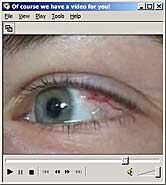 Video (WMV): Hi-Res | Low-Res (High resolution clip is 2 MB, low resolution clip is 0.5 MB. Both are Windows WMV video files). |
But, the trip was over and all that was left was my final appointment with Dr. Melles. He seemed very concerned that the star was a little lower down on my eye than he’d wanted, and asked me to let him know if I ever became unsatisfied and wanted it shifted slightly. He even gave me a note to take to an ophthalmologist locally. But, other than his concern about the aesthetics of the placement, there were no problems and everything seemed normal and healthy.
I want to say that Dr. Gerrit Melles (who developed this procedure as well as being the one who performed it on me) has a really wonderful bedside manner. He treated me kindly and with respect throughout our entire interaction — sadly, not the response a young, heavily tattooed woman is used to getting in this world. He took the time to explain everything in detail before, and as it was happening, which helped keep me calm. I felt like he was talking to me and not “at me”. He went out of his way to make sure I knew to contact him personally if I had any concerns.
As of today I’ve had a platinum star under the surface of my left eye for six days. Healing has been uneventful, and at 750 Euros (about $900 US), even with the price of the airfare and accommodations it cost no more than a large tattoo would. I don’t really know why I wanted it — something about it just struck me. Why do I like a certain hair style, or why do I like a certain song? I thought it was pretty. Whether it comes to mean more or less to me in the future, time will tell, but, I think Dr. Melles put it well when he explained that in all of human history, people have decorated themselves with jewelry. Of all our organs, one can argue that the eye is the most important in social interaction — now that we can do it safely, is eyeball jewelry really that strange?

Rachel Larratt
BMEzine.com
| Rachel Larratt is the copublisher of BMEzine.com, the largest and oldest full-spectrum body modification publication on the planet. Her background is as diverse as one would expect of BME’s coowner, and includes everything from body piercing to developing technology for high-bandwidth media distribution.. |
Copyright © 2004 BMEzine.com Requests to republish complete, edited or shortened versions must be confirmed in writing. For bibliographical purposes this article was first published June 1st, 2004 by BMEZINE.COM in Toronto, Ontario, Canada.
